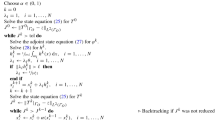Abstract
We report on an investigation into using a Level Sets based method to reconstruct activation wavefronts at each time instant from measured potentials on the body surface. The potential map on the epicardium is approximated by a two level image and the inverse problem is solved by evolving a boundary, starting from an initial region, such that a filtered residual error is minimized. The advantage of this method over standard activation-based solutions is that no isotropy assumptions are required. We discuss modifications of the Level Sets method used to improve accuracy, and show the promise of this method via simulation results using recorded canine epicardial data.
Preview
Unable to display preview. Download preview PDF.
Similar content being viewed by others
References
Brooks, D.H., MacLeod, R.S.: Electrical Imaging of the Heart: Electrophysical Underpinnings and Signal Processing Opportunities. IEEE Sig. Proc. Mag. 14(1), 24–42 (1997)
Rudy, Y., Messinger-Rapport, B.: The inverse problem of electrocardiography. Solutions in terms of epicardial potentials. CRC Crit. Rev. Biomed. Eng. 16, 215–268 (1988)
Huiskamp, G.J.M., van Oosterom, A.: The depolarization sequence of the human heart surface computed from measured body surface potentials. IEEE Trans. Biomed. Eng. BME35, 1047–1058 (1988)
Huiskamp, G.J.M., Greensite, F.S.: A new method for myocardial activation imaging. IEEE Trans. Biomed. Eng. 44, 433–446 (1997)
Pullan, A.J., Cheng, L.K., Nash, M.P., Bradley, C.P., Paterson, D.J.: Noninvasive electrical imaging of the heart: theory and model development. Annals of Biomedical Eng. 29(10), 817–836 (2001)
Oostendorp, T., Macleod, R.S., van Oosterom, A.: Non-invasive determination of the activation sequence of the heart: Validation with invasive data. In: Proc. IEEE Int. Conf. Eng. in Med. and Biol. Soc. (1997)
Brooks, D.H., Ahmad, G.F., MacLeod, R.S., Maratos, G.M.: Inverse Electrocardiography by Simultaneous Imposition of Multiple Constraints. IEEE Trans. Biomed. Eng. 46(1), 3–18 (1999)
Messnarz, B., Tilg, B., Modre, R., Fischer, G., Hanser, F.: A new spatiotemporal regularization approach for reconstruction of cardiac transmembrane potential patterns. IEEE Trans. Biomed. Eng. 51(2), 273–281 (2004)
Santosa, F.: A Level-Set Approach for Inverse Problems Involving Obstacles. ESAIM: Control, Optimisation and Calculus of Variations 1, 17–33 (1996)
Osher, S., Sethian, J.A.: Fronts Propagating with Curvature-Dependent Speed: Algorithms Based on Hamilton-Jacobi Formulations. Journal of Computational Physics 79, 12–49 (1988)
Sethian, J.A.: Level Set Methods and Fast Marching Methods, 2nd edn. Cambridge University Press, Cambridge (1999)
MacLeod, R.S., Ni, Q., Punske, B., Ershler, P.R., Yilmaz, B., Taccardi, B.: Effects of Heart Position on the Body-Surface ECG. J. Electrocardiol. 33(suppl.), 229–237 (2000)
MacLeod, R.S., Johnson, C.R.: Map3d: Interactive scientific visualization for bioengineering data. In: Proc. Int. Conf. IEEE Eng. Med. Bio. Soc., pp. 30–31 (1993)
Author information
Authors and Affiliations
Editor information
Editors and Affiliations
Rights and permissions
Copyright information
© 2005 Springer-Verlag Berlin Heidelberg
About this paper
Cite this paper
Calderero, F., Ghodrati, A., Brooks, D.H., Tadmor, G., MacLeod, R. (2005). A Method to Reconstruct Activation Wavefronts Without Isotropy Assumptions Using a Level Sets Approach. In: Frangi, A.F., Radeva, P.I., Santos, A., Hernandez, M. (eds) Functional Imaging and Modeling of the Heart. FIMH 2005. Lecture Notes in Computer Science, vol 3504. Springer, Berlin, Heidelberg. https://doi.org/10.1007/11494621_20
Download citation
DOI: https://doi.org/10.1007/11494621_20
Publisher Name: Springer, Berlin, Heidelberg
Print ISBN: 978-3-540-26161-2
Online ISBN: 978-3-540-32081-4
eBook Packages: Computer ScienceComputer Science (R0)




